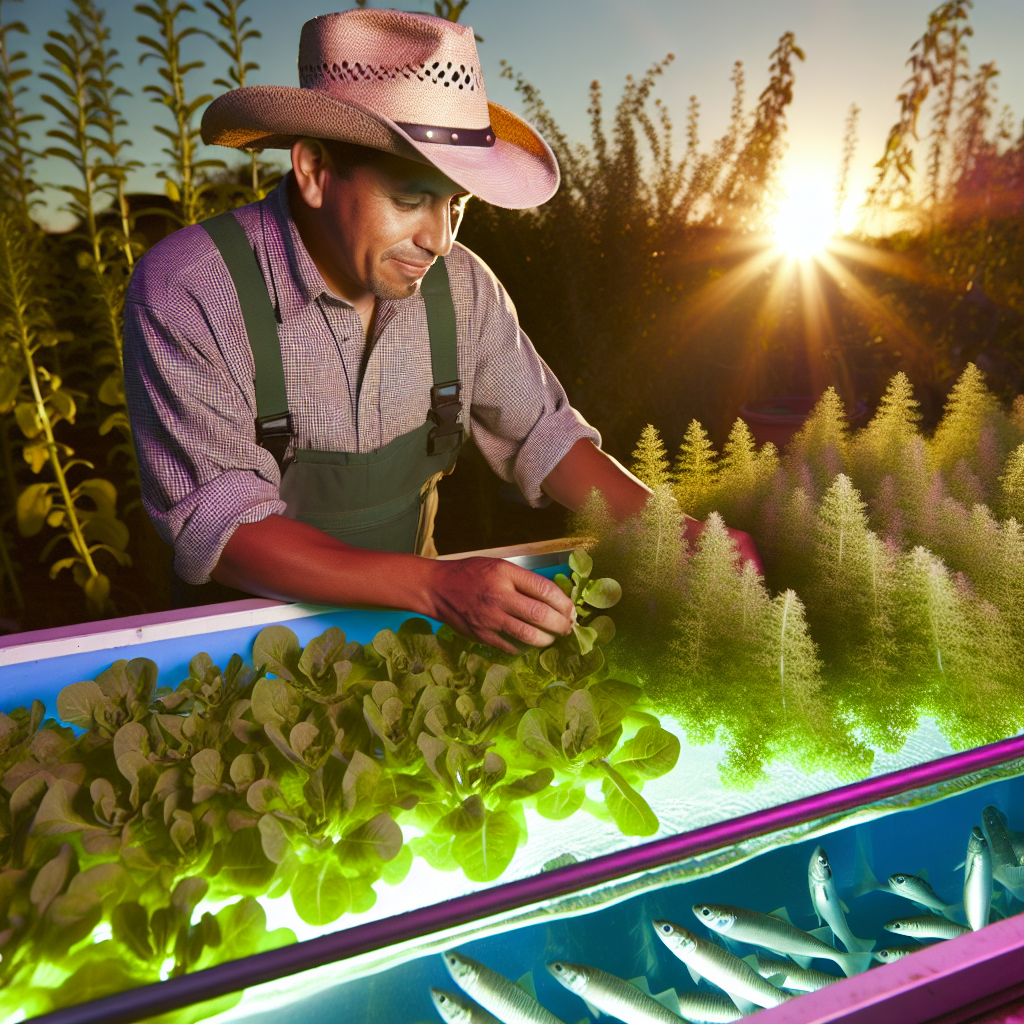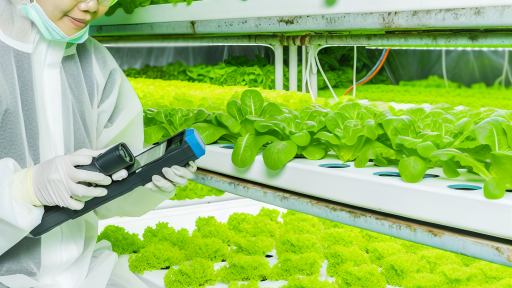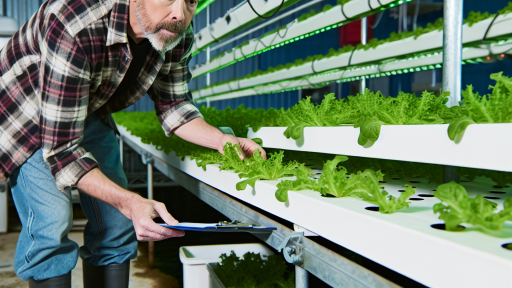Introduction to Aquaponics and its Importance in Sustainable Agriculture
Defining Aquaponics
Aquaponics combines aquaculture and hydroponics in a sustainable system.
This technique involves cultivating fish and plants together in a synergistic environment.
Essentially, fish waste provides organic nutrients for the plants.
In turn, plants purify the water for the fish, creating a closed-loop system.
The Role of Aquaponics in Sustainability
Aquaponics optimizes water usage compared to traditional farming methods.
This method uses up to 90% less water than conventional agriculture.
Additionally, aquaponics eliminates the need for synthetic fertilizers.
Such practices reduce chemical runoff into local waterways.
Benefits to Food Security
Aquaponics enhances food security by improving local food production.
It allows for year-round crop production regardless of climate conditions.
Urban areas can thus become more self-sufficient in food sourcing.
Promoting Biodiversity
This farming approach encourages biodiversity within the ecosystem.
Aquaponics can support various plant species alongside fish populations.
Such diversity contributes to healthier ecosystems overall.
Challenges and Considerations
Despite its advantages, aquaponics requires careful management and knowledge.
Transform Your Agribusiness
Unlock your farm's potential with expert advice tailored to your needs. Get actionable steps that drive real results.
Get StartedBoth fish and plants must thrive, necessitating balanced conditions.
Moreover, start-up costs can be higher compared to traditional farming.
Future of Aquaponics
As food demands grow, aquaponics presents a viable solution.
Research and technology advancements are improving efficiency and sustainability.
Community education and support can further promote aquaponics practices.
Key Components of Aquaponics Systems
Fish
Fish are a vital component of aquaponics systems.
They provide essential nutrients for plant growth.
Common choices include tilapia, catfish, and trout.
Each fish species has different care requirements.
Maintaining optimal water conditions is crucial for fish health.
Additionally, fish waste serves as organic fertilizer for plants.
Plants
Plants thrive in aquaponics systems thanks to nutrient-rich water.
Leafy greens, herbs, and tomatoes are ideal candidates.
Each plant type varies in its nutrient and light needs.
Plants help filter and clean the water for the fish.
Consequently, they create a symbiotic relationship within the system.
Furthermore, the growth cycle of plants aligns with fish feeding schedules.
Bacteria
Bacteria play a crucial role in aquaponics systems.
They facilitate the breakdown of fish waste into usable nutrients.
Nitrosomonas and Nitrobacter are examples of beneficial bacteria.
These bacteria convert ammonia into nitrites and nitrates.
Maintaining a healthy bacteria population is essential for system balance.
Overall, bacteria are the unseen heroes of aquaponics farming.
Integration of Components
All components must work together efficiently.
Showcase Your Farming Business
Publish your professional farming services profile on our blog for a one-time fee of $200 and reach a dedicated audience of farmers and agribusiness owners.
Publish Your ProfileFish, plants, and bacteria create a self-sustaining ecosystem.
Water circulates through the system, benefitting all parties.
This harmony reduces the need for chemical fertilizers.
Moreover, it minimizes water usage compared to traditional farming.
Ultimately, successful aquaponics relies on understanding these relationships.
Benefits of Aquaponics: Water Conservation and Waste Reduction
Water Conservation
Aquaponics systems use significantly less water than traditional farming methods.
This method recycles water efficiently within the system.
Plants in aquaponics absorb the water they need from fish tanks.
Consequently, less water is wasted compared to soil-based farming.
Additionally, the closed-loop system minimizes evaporation and run-off.
The integration of fish and plants optimizes water usage further.
Overall, aquaponics can reduce water consumption by up to 90%.
Waste Reduction
Aquaponics effectively transforms waste into valuable resources.
Fish produce waste that supplies essential nutrients for plants.
This natural process reduces the need for chemical fertilizers.
Moreover, it addresses waste management by recycling nutrients.
The system promotes a symbiotic relationship between fish and plants.
As a result, less waste is released into the environment.
This method encourages a sustainable approach to food production.
By minimizing waste and maximizing resource use, aquaponics promotes ecological balance.
See Related Content: The Power of Container Farming: A Guide to High-Yield Gardens
Comparison of Aquaponics with Traditional Farming Methods
Resource Utilization
Aquaponics utilizes water more efficiently than traditional farming.
It recycles water through a closed-loop system.
This reduces the overall water consumption significantly.
Furthermore, it minimizes waste production.
In contrast, traditional farming often results in considerable water wastage.
Space Efficiency
Aquaponics systems require less land to produce the same amount of food.
They allow vertical farming, which maximizes growing space.
This practice helps urban areas grow food closer to consumers.
Traditional farming, however, requires large plots of land.
This can lead to habitat destruction and loss of biodiversity.
Crop and Fish Diversity
Aquaponics supports a diverse range of fish and plants.
Farmers can cultivate various vegetables along with fish.
This enhances biodiversity in food production.
On the other hand, traditional farming often focuses on monocultures.
This can lead to pest issues and soil depletion over time.
Pesticide and Chemical Use
Aquaponics significantly reduces the need for pesticides and herbicides.
Natural processes control pests and diseases in these systems.
In traditional farming, chemicals are often necessary for crop protection.
Consequently, this can lead to soil and water contamination.
Showcase Your Farming Business
Publish your professional farming services profile on our blog for a one-time fee of $200 and reach a dedicated audience of farmers and agribusiness owners.
Publish Your ProfileEconomic Aspects
Aquaponics can lead to lower operational costs in the long run.
Initial investments may be higher, but efficiency pays off.
Aquaponics can also shorten the supply chain.
This can lead to fresher produce and higher profits for farmers.
Traditional farming may involve higher costs for transportation and storage.
Environmental Impact
Aquaponics fosters a sustainable approach to agriculture.
It reduces carbon footprint compared to conventional farming methods.
In addition, it conserves water and promotes ecosystem health.
Conversely, traditional farming often depletes natural resources.
This can lead to soil erosion and nutrient loss over time.
Uncover the Details: Micro-Farming in Urban Spaces: Turning Tiny Plots into Productive Farms
Sustainable Fish Farming Practices
Species Selection
Selecting the right fish species is crucial for sustainability.
Some species thrive in aquaponic systems better than others.
For freshwater systems, tilapia, catfish, and trout are popular choices.
Each species has different care needs and growth rates.
Moreover, local environmental conditions affect species selection.
Always consider the water temperature and chemistry.
Research native species as they often adapt better to local ecosystems.
Fish Care Practices
Proper care enhances the health and longevity of fish.
Maintain optimal water quality to support fish well-being.
Regularly monitor pH levels, ammonia, and nitrite concentrations.
Use filtration systems to keep water clean and clear.
Feeding practices also play a vital role in sustainable fish farming.
Choose high-quality feed that minimizes waste and promotes growth.
Additionally, avoid overfeeding to reduce water pollution.
Regular health checks will help identify and address issues early.
Responsible Sourcing
Considering the sourcing of fish is essential for sustainability.
Opt for fish from reputable suppliers who practice ethical breeding.
Look for certifications that endorse sustainable aquaculture practices.
Support local hatcheries whenever possible to boost the local economy.
When wild-caught species are necessary, verify sustainable fishing practices.
Stocking Density Considerations
Proper stocking density is critical in aquaponics systems.
Too many fish increase competition for resources and stress levels.
Identify the optimal number of fish based on tank size and species.
Regularly assess the health of fish to ensure they thrive.
Adjust the stocking density based on growth rates and health assessments.
Uncover the Details: Urban Homesteading: Growing Your Own Food in Limited Spaces
Integrated Pest Management in Aquaponics: Natural Solutions
Understanding Integrated Pest Management
Integrated pest management (IPM) combines different strategies to control pests effectively.
This approach reduces reliance on chemical pesticides.
Furthermore, it minimizes environmental impacts while supporting ecosystem health.
Showcase Your Farming Business
Publish your professional farming services profile on our blog for a one-time fee of $200 and reach a dedicated audience of farmers and agribusiness owners.
Publish Your ProfileBenefits of IPM in Aquaponics
IPM promotes healthier crops in aquaponics systems.
It enhances fish health by reducing pesticide exposure.
Moreover, it leads to more sustainable production systems.
Natural deterrents play a crucial role in IPM strategies.
- Beneficial insects, such as ladybugs, can control aphid populations.
- Neem oil is an effective organic pesticide against various pests.
- Companion planting can confuse and repel harmful insects.
Farmers should consider these options to maintain balance.
Monitoring and Identification
Effective pest management starts with regular monitoring.
Farmers should inspect plants and fish routinely.
Identifying pests early can prevent significant damage.
Additionally, correct identification informs management strategies.
Educational Resources for Farmers
Farmers can benefit from various educational resources about IPM.
Extension services provide valuable local knowledge and support.
Online platforms offer webinars and instructional videos on IPM practices.
Networking with other aquaponics farmers can also share insights and tips.
Discover More: 7 Must-Try Techniques for Efficient Small-Scale Organic Farming

Nutrient Management: Utilizing Organic Inputs in Aquaponics
Importance of Nutrient Management
Nutrient management plays a crucial role in aquaponics systems.
It supports healthy plant growth and fish welfare.
Effective nutrient management enhances the overall system efficiency.
Organic Inputs in Aquaponics
Organic inputs are essential for maintaining nutrient balance.
They promote soil health and sustainability in aquaponics.
Common organic inputs include compost, manure, and biochar.
Utilizing Compost
Compost enriches the aquaponics system with organic matter.
It improves soil structure and enhances microbial activity.
Furthermore, compost provides essential nutrients to plants.
Implementing Manure
Manure is a valuable organic input for aquaponics farms.
It supplies nitrogen and other key nutrients to the system.
To ensure safety, properly composted manure is recommended.
Using Biochar
Biochar serves as a soil amendment in aquaponics systems.
It enhances nutrient retention and improves water holding capacity.
Moreover, biochar contributes to carbon sequestration efforts.
Benefits of Organic Nutrient Inputs
Organic nutrient inputs improve plant biodiversity in aquaponics.
Healthy plants are more resilient to pests and diseases.
Additionally, organic practices enhance the taste and quality of produce.
Implementing a Nutrient Cycle
Creating a nutrient cycle is vital for sustainability in aquaponics.
This cycle reuses waste from fish to nourish plants.
In turn, plants clean the water for the fish.
Monitoring Nutrient Levels
Regular monitoring of nutrient levels ensures system balance.
Tools like water testing kits can help track nutrient content.
Adjustments can be made based on specific crop needs.
Adapting to Plant Needs
Understanding the nutrient requirements of different plants is essential.
Some plants demand more nitrogen, while others thrive with phosphorus.
Showcase Your Farming Business
Publish your professional farming services profile on our blog for a one-time fee of $200 and reach a dedicated audience of farmers and agribusiness owners.
Publish Your ProfileAdapting nutrient inputs accordingly leads to healthier yields.
Future Directions for Sustainable Aquaponics
Incorporating organic inputs in aquaponics promotes sustainability.
Future research can explore new organic materials for nutrient management.
Ultimately, these practices will advance eco-friendly agriculture.
The Role of Renewable Energy in Sustainable Aquaponics Operations
Understanding Renewable Energy Sources
Renewable energy sources are crucial for sustainable aquaponics farming.
They include solar, wind, and hydroelectric power.
Using these sources minimizes reliance on fossil fuels.
Furthermore, they reduce greenhouse gas emissions significantly.
Integrating Solar Energy into Aquaponics
Solar energy provides an effective solution for powering aquaponics systems.
Photovoltaic panels can generate electricity for pumps and lighting.
Moreover, solar heating can manage water temperatures in fish tanks.
By harnessing solar power, farmers can decrease their energy costs.
Utilizing Wind Energy for Sustainable Operations
Wind energy can complement solar power in aquaponics farming.
Wind turbines produce electricity that supports system operations.
This energy source is particularly useful in windy regions.
Farmers can enhance sustainability by integrating wind energy into their practices.
Benefits of Renewable Energy in Aquaponics
Renewable energy sources offer numerous benefits in aquaponics.
- They lower operating costs for farmers.
- They increase the environmental sustainability of operations.
- They provide a stable energy supply, minimizing disruptions.
Challenges in Implementing Renewable Energy
Despite the benefits, challenges exist in adopting renewable energy.
High initial investment costs can deter farmers from transitioning.
Inconsistent energy production can pose operational challenges.
However, advancements in technology are helping to mitigate these issues.
Future of Renewable Energy in Aquaponics
The future looks bright for renewable energy in aquaponics farming.
Increased efficiency and lower costs are driving faster adoption.
Moreover, governmental incentives promote the use of clean energy.
As technology progresses, the integration of renewable energy will likely expand.
Challenges and Solutions for Implementing Sustainable Aquaponics
Understanding the Key Challenges
Implementing sustainable aquaponics presents various challenges.
One major challenge is the initial setup cost of the system.
Additionally, maintaining the balance between fish and plants requires expertise.
Environmental factors, such as water quality, can also impact the system.
Moreover, pests and diseases pose a significant threat to both fish and plants.
Addressing Financial Barriers
High startup costs often deter potential aquaponics farmers.
To overcome this challenge, seeking grants can provide financial support.
Investing in energy-efficient systems will reduce long-term operational costs.
Furthermore, crowdfunding can help finance aquaponics projects.
Sharing knowledge through community resources can also reduce expenses.
Managing Technical Expertise
Technical knowledge is crucial for successful aquaponics practices.
Farmers can attend workshops to improve their skills.
Online courses also provide valuable education on aquaponics systems.
Connecting with experienced practitioners fosters sharing of best practices.
Regularly consulting experts enhances the farmers’ problem-solving abilities.
Showcase Your Farming Business
Publish your professional farming services profile on our blog for a one-time fee of $200 and reach a dedicated audience of farmers and agribusiness owners.
Publish Your ProfileEnsuring Environmental Sustainability
Maintaining water quality is essential for the health of fish and plants.
Regular testing of water parameters helps identify issues early.
Utilizing organic methods to control pests supports sustainability goals.
Implementing renewable energy sources can minimize environmental impact.
Thus, integrating sustainable practices leads to healthier ecosystems.
Enhancing Resilience Against Diseases
Diseases can devastate aquaponics systems if left unmanaged.
Employing biosecurity measures reduces the risk of disease outbreaks.
Regular monitoring of fish and plant health allows for early intervention.
Incorporating companion planting techniques can deter pests naturally.
Engaging in research keeps farmers updated on disease management practices.
Future Trends in Aquaponics: Innovations for Sustainability
Emerging Technologies
Technological advancements drive aquaponics toward sustainability.
Innovations include automated systems for water management.
Smart technologies monitor plant and fish health effectively.
For instance, IoT devices collect real-time data seamlessly.
These technologies reduce human error and improve efficiency.
Moreover, they allow remote management of aquaponics farms.
Sustainable Energy Solutions
Implementing renewable energy sources enhances sustainability.
Solar panels reduce dependence on fossil fuels in aquaponics.
Wind energy can supplement power needs in some regions.
Using bioenergy from waste products contributes further.
These solutions lower operating costs significantly.
Consequently, farms can operate in a more eco-friendly manner.
Vertical Farming Integration
Vertical farming aligns well with aquaponics principles.
This method maximizes space usage, producing more food.
Additionally, it minimizes land degradation significantly.
By integrating both methods, farms become more versatile.
This approach leads to higher yields in urban environments.
Furthermore, it increases local food availability and reduces transportation needs.
Community Engagement and Education
Fostering community involvement boosts awareness of aquaponics.
Educational programs teach sustainable practices effectively.
Workshops allow individuals to experience aquaponics hands-on.
Local partnerships can enhance resource sharing and knowledge transfer.
Engaging diverse audiences creates greater support for aquaponics initiatives.
Ultimately, this fosters a culture of sustainability in agriculture.
Research and Collaboration
Collaboration between researchers and farmers strengthens aquaponics.
Ongoing studies improve techniques for better sustainability.
Sharing successful practices encourages widespread adoption.
Collaborative efforts can lead to innovative solutions for challenges.
Additionally, research can identify optimal crop and fish combinations.
This shared knowledge enhances overall production efficiency.
Showcase Your Farming Business
Publish your professional farming services profile on our blog for a one-time fee of $200 and reach a dedicated audience of farmers and agribusiness owners.
Publish Your ProfileAdditional Resources
FCS3378/FY1517: Social and Community Benefits and Limitations …




